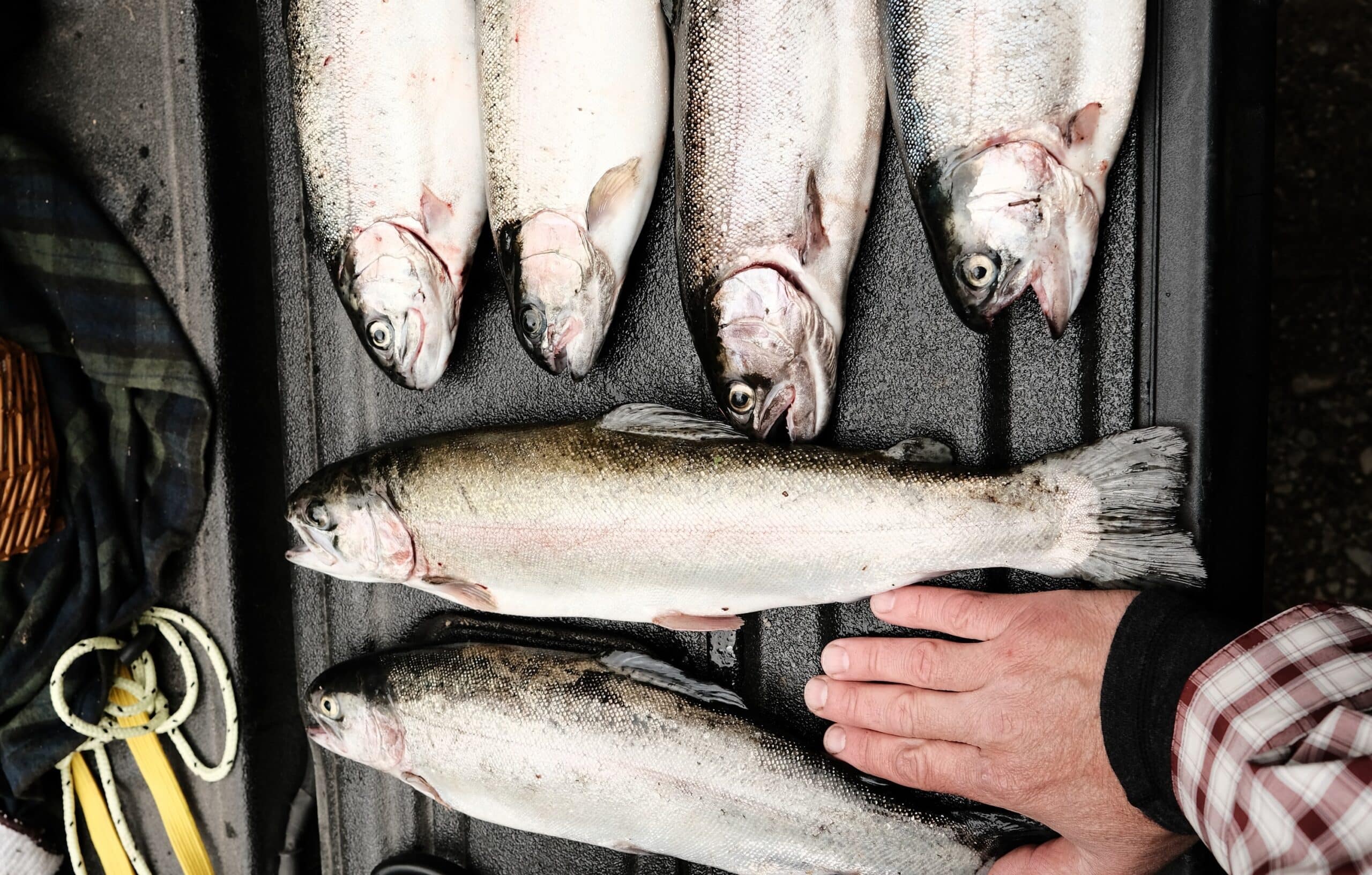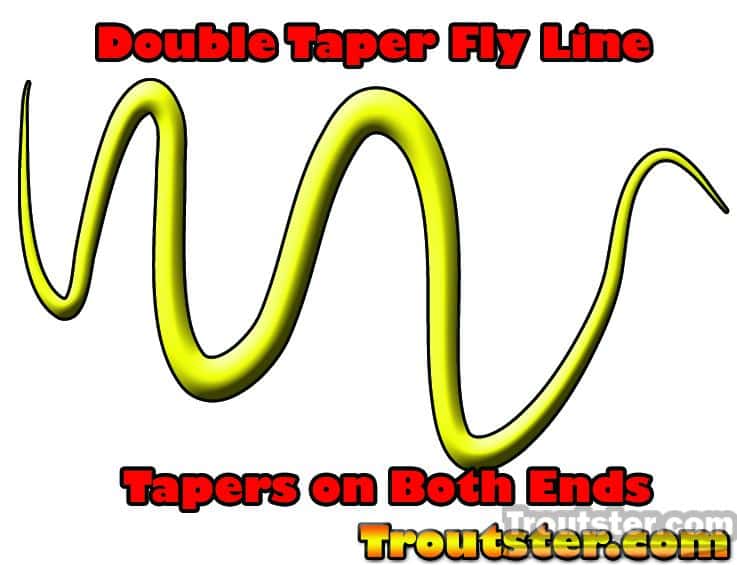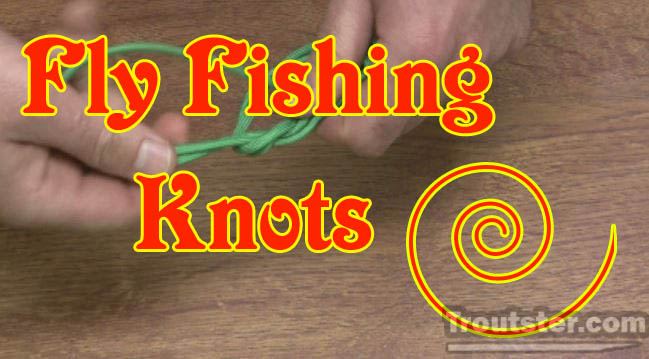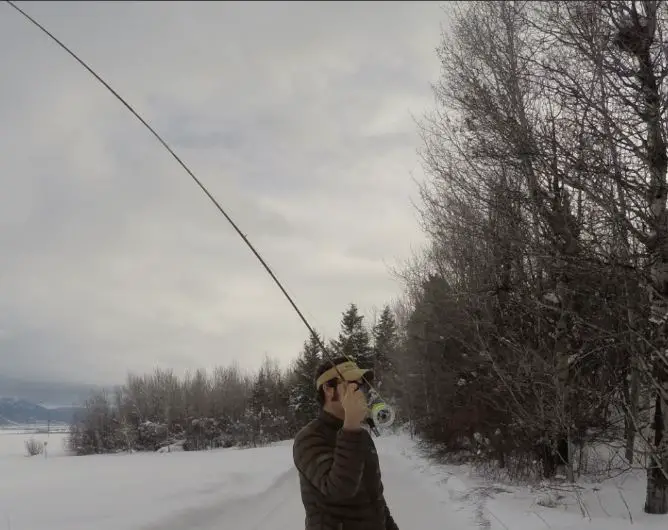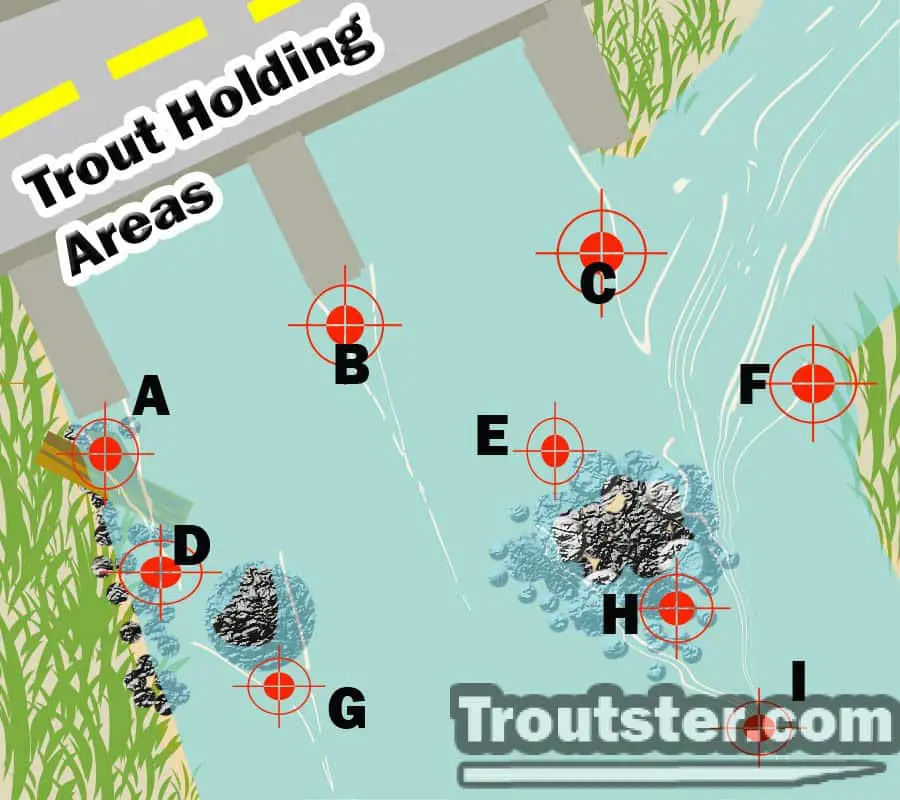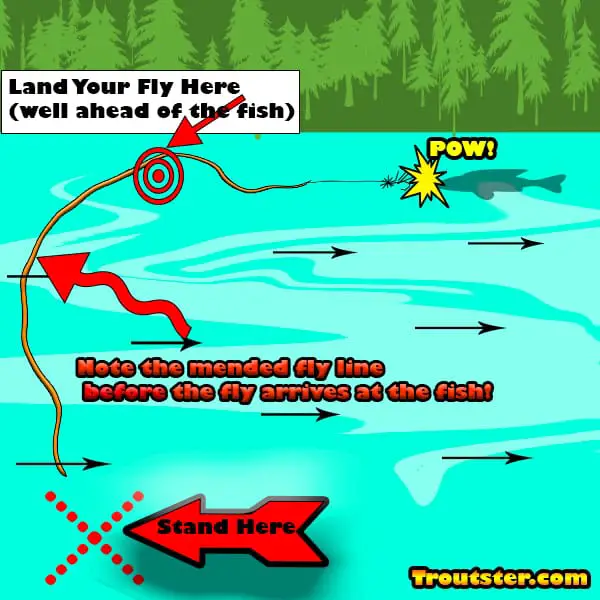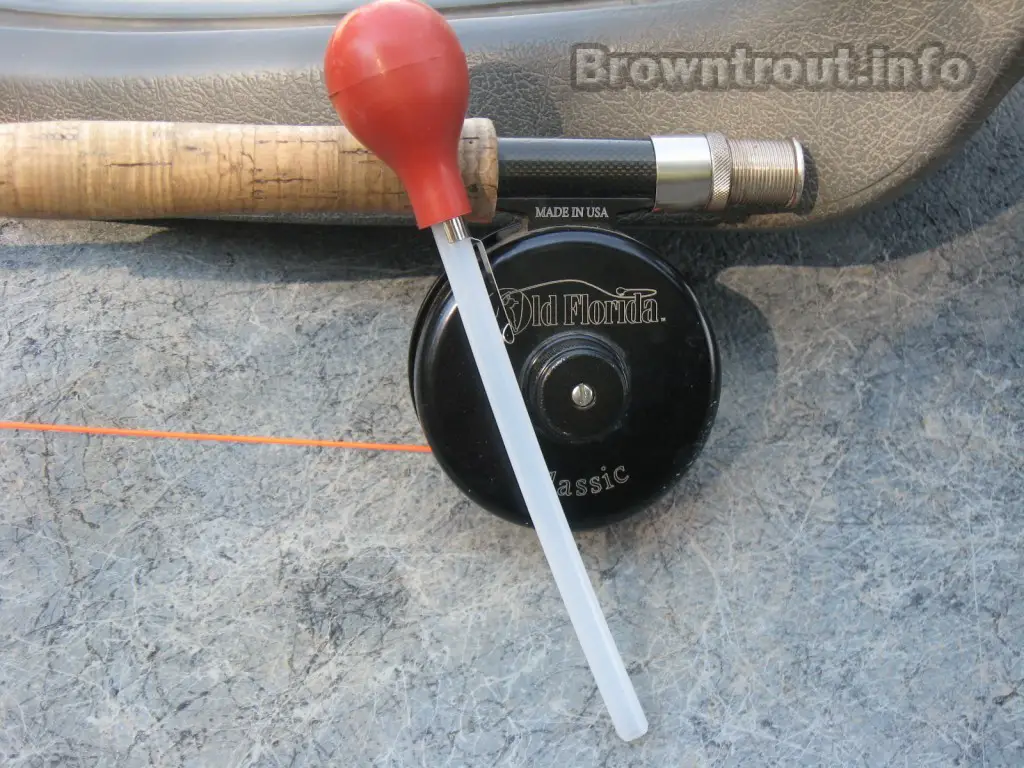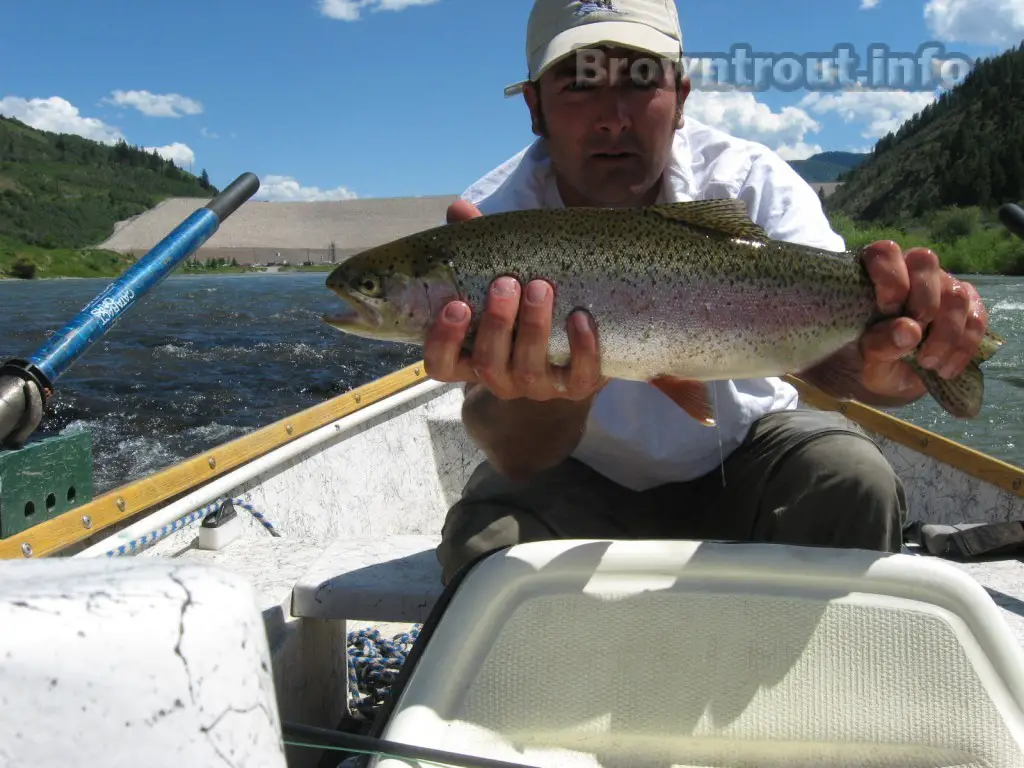This post was last updated on August 6th, 2021 at 08:48 am
Fly fishing for trout is perhaps very intimidating for new people to get into. There are so many little things you need to know to excel at this great sport. On this website, we will do everything possible to teach you all of the small details it takes to fly fish for trout. We’ll start right here on this page to give you some of the basics you will need to get your foot in the door of fly fishing. This is the ultimate guide about how to fly fish for trout including casting tips, gear info, fly info and much more. Read on to learn everything you need to know about fly fishing for trout.
Class is in session! Every aspect of learning how to fly fish for trout will be covered on this page. It has taken me years to write all of this learning material and I am happy to finally put it all together in one easy to follow place for you to learn it all.

Check out this infographic to learn more about fly fishing gear. Copy and paste the code below the infographic to display this on your website for free!
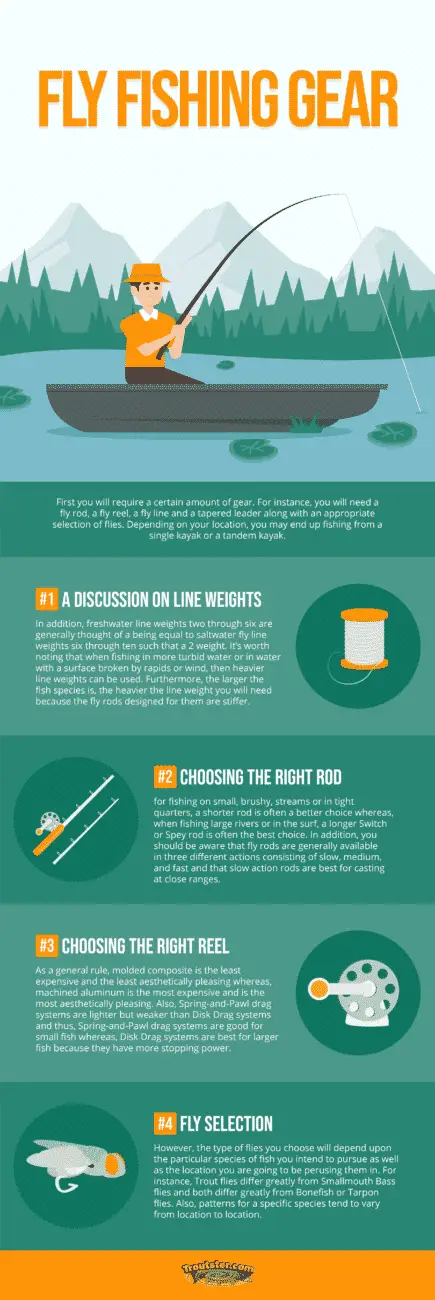 <a href=”https://troutster.com/how-to-fly-fish-for-trout/” title=”Fly Fishing Gear”><img src=”https://troutster.com/wp-content/uploads/fly-fishing-gear-infographic.png” width=”100%” style=”max-width: 850px;” alt=”Fly Fishing Gear”></a><br>Provided by <a href=”https://troutster.com/” target=”_blank”>Troutster</a>
<a href=”https://troutster.com/how-to-fly-fish-for-trout/” title=”Fly Fishing Gear”><img src=”https://troutster.com/wp-content/uploads/fly-fishing-gear-infographic.png” width=”100%” style=”max-width: 850px;” alt=”Fly Fishing Gear”></a><br>Provided by <a href=”https://troutster.com/” target=”_blank”>Troutster</a>
Choose Your Fly Fishing Rod and Reel
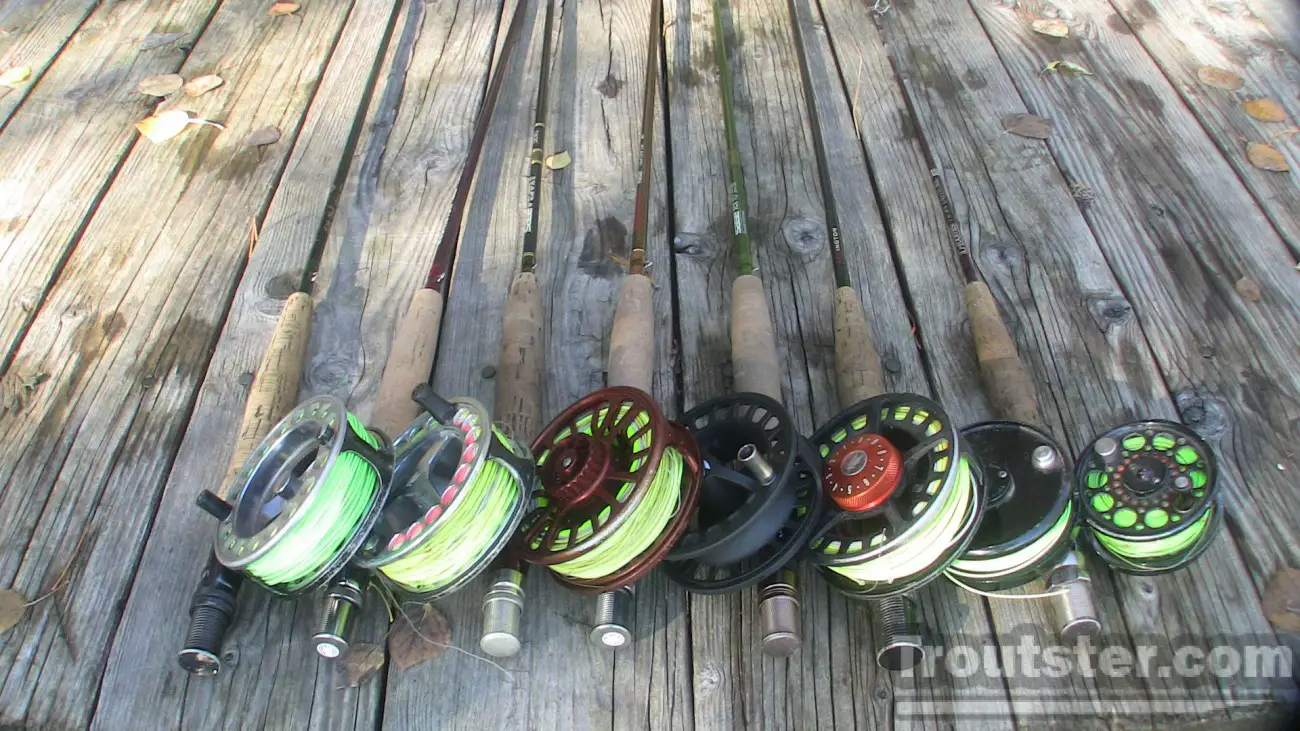
Choosing a fly rod and reel is an important decision. Buying the proper gear will make learning how to fly fish much easier than if you were to just buy cheap inferior gear and go fishing. Learning the fly fishing basics with the appropriate gear will make your learning and beginning fishing experience a lot more enjoyable.
Basically you should choose a rod in the 4, 5 or 6 weight category and buy the best one you can afford. If you are looking to save money, I would buy a cheap reel and spend a little extra on a nice rod. This will make learning easier. I learned how to flyfish with a cheap rod that costed under 20$. I did learn, but i would have learned faster and I would have been less frustrated with a better rod. If I wasn’t extremely stubborn, I likely would have quit because casting that beast was a real bear for my young arms. A good fly rod will launch your flies with minimal effort, while a heavy cheap one will make you think it is harder than it actually is.
More rod and reel resources:
Choose Your Fly Line
Fly line is another area where you shouldn’t go cheap. Your fly fishing line is the link between you and the fish. Cheap fly line will hurt your casting distance and overall make your fishing experience less successful. You would absolutely notice a difference if you were to cast good line and cheap line side by side. In fly lines, you have a few different choices to make. Most new fly fisherman will prefer to buy a weight forward line, meaning the end that you are casting out will have more weight than the end still on your reel. Learn more about selecting the best fly line for trout in the resources below.
More fly line resources:
- Choosing the best fly line for trout
- What is fly line backing and do I need it?
- What is a leader, tippet and butt section?
- How to set up a fly reel with line
Basic Gear Needed for Trout Fly Fishing – Fly Fishing Setup
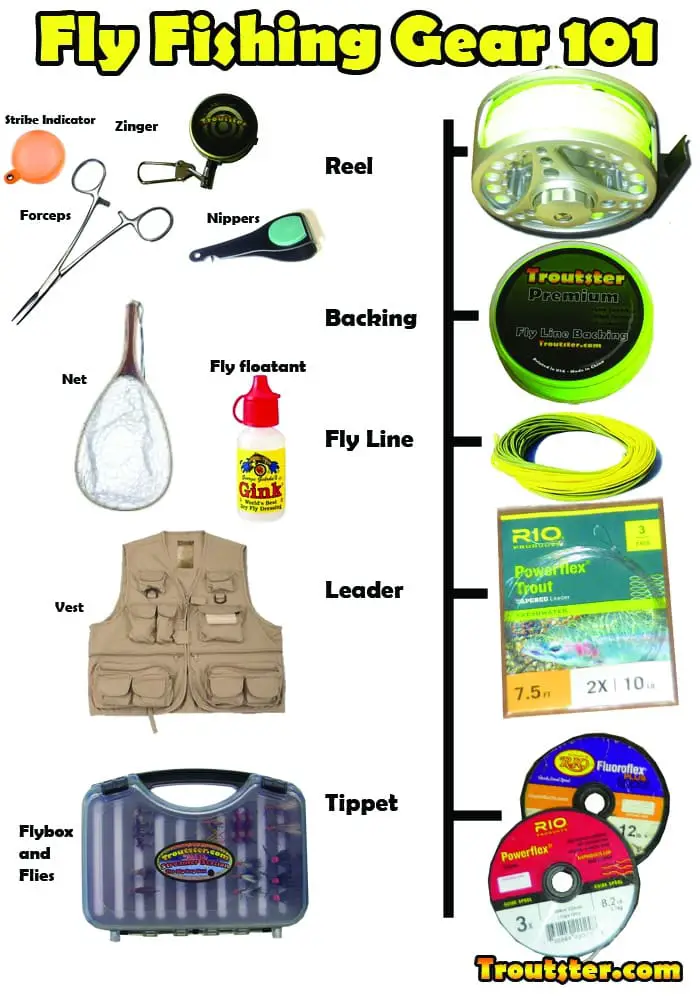
If you are just getting into fly fishing and you need to know the gear required to get started, you have come to the right place. Starting new sports (especially ones as involved as fly fishing) can seem confusing and complicated to get your foot in the door. As a beginner fly fisherman, you are quite possibly looking at a sport that will change your life for the better forever. Getting started with the right gear is essential. One common misconception about this hobby is that it has to cost a fortune to buy all of the necessary gear; in reality, you can be on a trout stream tomorrow hooking fish for less than a few hundred dollars. Granted, $300 is not going to outfit you with the best equipment on the market, but it will be good enough for you to test the waters and decide if you are going to commit.
- The Fly Fishing Rod: This is obviously a mandatory item. You should be able to find a good rod in the $100 range easily, not to mention it might even come standard with a lifetime warranty! You can visit the best fly rods for the money post for more information on choosing a great trout fly fishing rod for a super deal.
- Fly Reel: Reels are less important for the trout fisherman than the rod. This is a good place to save some money and go mid-grade. I would try to find a reel in the $50-60 range (unless you feel like spending more). Okuma among many other brands makes quality reels with good drags for reasonable prices.
- Fly Line: Line is not something you want to get cheap on, expect to pay $40-60 for good fly fishing line. You can find out the differences between various types of fly lines here.
- Leaders, Tippets and Backing: These basics are all mandatory as well, but won’t cost you too much at all. You can buy leaders for $3 dollars each and tippet for about the same amount per spool. You will probably want 2x, 3x, and 4x sized tippets at a minimum. If you don’t know what tippets, leaders and backing are, you can find in this article about fly fishing line.
That sums up what you need as far as the rod, reel and rigging needs. If you need to learn how to put all of it together, you can find out how to set up a fly reel here. Alternatively, you could buy a complete fly fishing kit that includes everything you need to get started including an instructional DVD
Small Fly Fishing Accessories You Should Own
-
- Nippers: These are used to cut line and to clean out those manly outdoor dirt infested fingernails
- Fly Floatant: This is used to keep your trout flies floating on the surface of the water.
- Retractable Zinger: These will help you keep your nippers conveniently located, because you will need them each time you change flies or retie.
- Net: A net will help you to land fish quickly and keep them in the water while you dig out your camera.
- Fly fishing Vest: To keep organized you should have all of your vital equipment in one place. A vest, backpack or chest pack will be required. (See the Redington clark fork mesh vest review here)
- Forceps: A great fly fishing accessory to keep in your vest. You never know when you will need these. Forceps or hemostats are very helpful for removing hooks from fish.
Optional Fly Fishing Equipment:
- Fly Fishing Waders: If the water is too cold and wading in shorts or breathable pants is not an option. I am a big fan of wearing just sandals and pants for wading unless it is very cold.
- Wading boots: Some waders come with wading boots attached, often times you will have to buy them separate. Check here to find out if your state has special laws regarding felt soled boots.
Don’t forget to get a fishing license for your state and read up on the local laws and open fishing areas etc. You might be able to find a trout stream near you here on the interactive fishing maps page.

Learning to Tie Fly Fishing Knots – Trout Fly Fishing
This part is easy. Now that you have all of the gear needed to enter into this great sport successfully, you are ready to start learning. Tying knots is a very important skill for you to master. You can have all of the finest gear in the world, but if you don’t know how to tie the knots, you will lose fish. Read this article about tying fly fishing knots to learn the essential skills. Most of the knots have easy to follow videos to make learning these knots easy and fun.
More fly tying resources:
Fly Fishing Casting for Trout
Learning fly fishing casting for trout can be one of the trickiest parts of fly fishing. If you start doing it wrong, you could end up finding it hard to break those bad habits. It is best to learn from someone who truly knows what they are doing. Your uncle Jerry might tell you that he is an amazing fly fisherman, but the fact is, he might not really know what he is doing. If he teaches you wrong, you could be destined to a long hard road to fixing the bad habits that you have picked up from him. It’s best to get a firm grasp on the movements by watching instructional videos of pros and taking classes, that way you know you aren’t learning “wrong”. As a fishing guide, I am well aware of how hard bad habits can be to break after you have been “practicing” for weeks.
Read this article about how to cast a fly rod and watch the instructional video as well. This should get you on the right track to becoming a good fly caster.

How to Find Fish – Analyzing the River for Good Fishing Spots
Figuring out where trout hide, will have you hooking more fish than you ever thought possible. “Reading the water” is what separates great fisherman from people who never catch fish. Sure there is a lot more to it than that, but overall, if you are fishing in the wrong spots—you will not catch many trout. Click the “how to find fish” link above to learn about where trout like to hang out. Learning how to fly fish involves a bit more than just being able to cast. “Knowing” that a certain spot has fish just by looking at it, is right where you want to be—once there, you’ll catch plenty of fish.
Basically, most trout that are actively feeding will be sitting in certain areas that will provide them with a lot of food. You can learn to identify these spots and you will instantly begin catching a lot more fish. This post will also give you more information about where to find feeding trout.
Further Reading:
Casting at Trout and Learning to Stalk Feeding Fish
Learning to get within striking distance and closing the deal on a large trout can take some time. It’s easy to see fish, but actually pulling off the perfect drift and getting them to strike is a whole different ballgame. This article about dry fly fishing for trout will give you some pointers on how to carefully get within range of fish and how to minimize the risk of spooking them.
Further reading:
How to Set the Hook on a Trout
Setting the hook on trout is an often overlooked skill to learn (until you need to do it). Practicing your hook set is almost as important as your casting ability. When that fish strikes your fly, you need to instinctively set the hook, with a smooth transition into hauling it in. Check out the link above to learn how to smoothly transition from a hook set, to bringing the fish in. It is also a good idea to have a friend or family member pretend they are a fish pulling on your line, this will give you a fairly realistic practice session.
More links on this Subject:
How to Fight Fish – Trout Fly Fishing
Learning the tactics to fight fish is just as important as many other aspects of fly fishing. If you can’t land the fish, you’ll be missing out on an important skill. Check out this following video for some key tips to help you learn to effectively fight and land fish.
One of the most important tactics related to learning how to fly fish for trout is the ability to fight fish. During my days of guiding, I used to watch people freeze up during this critical time. After all of the casting lessons at the dock and all of the additional training, when the time comes to bring home the bacon and land the fish, that is when mistakes happen. Perhaps the biggest misconception about how to fight fish using a fly rod is that people always want to reel the fish in. Sure, you will need to reel it; but first, you need to take up the slack! Stripping line is imperative to bring in line quickly and ensure you are able to set the hook. The video above is sure to offer techniques that will help you on your journey. Learning how to fly fish for trout starts with casting and enticing fish, but if you can’t fight and land them, you’ll never be sending out that instagram of you holding that trophy fish. Fighting fish effectively is maintaining line control, just like every other aspect of this sport.
Choosing the Right Fly for Trout
Choosing the right fly at the right time is critical to learning how to catch trout regularly. You can be on the river the day before and every fish seems to be eating caddis, but the next day, nothing is eating them. We have all watched a picky trout eating relentlessly on the surface that refuses to touch our flies. Those fish are honed in on a particular insect and they will rarely deviate. Find out what that fly looks like and you are well on your way to hooking fish.
Further reading:
Finding the Best Dry Fly Pattern to Use
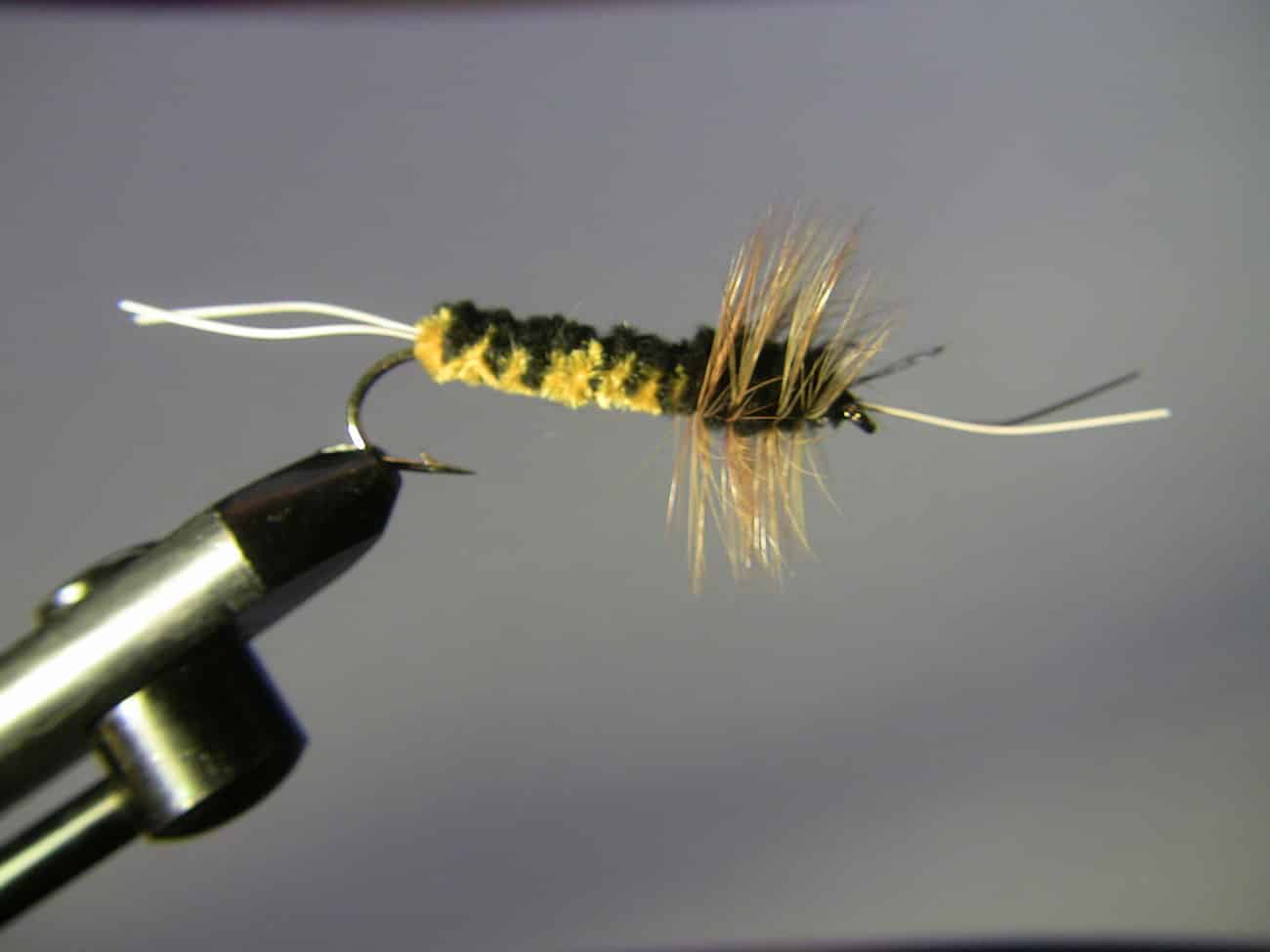
As long as you are seeing fish feeding on the surface, they will be easy to catch on dry flies. You just need to figure out what they want. If they aren’t feeding on the surface, you will have to go down after them. Trout are almost always willing to eat some sort of fly, your job is to find out what exactly that is.
If fish are feeding on the surface, you can go look in the nearby bushes and grass for any visible type of insect—better yet, if you see flies in the air, you’ll need to catch one. If you do manage to catch a fly, simply pick out of your fly box what matches it most closely, and you probably will have a winner. If not, you can keep watching for more insects. If the fish are heavily feeding and you cannot see flies on the water, there is a good chance they are eating emergers. To find out what insect is emerging, you have a couple options. A: you can bend over the water and watch very closely to see any flies floating just under the surface. Or B: Use a net of some sort and strain the water for insects. I guess you could also just try out a bunch of emerger patterns and hope for the best as well.
Further reading:
- Best fly box for various types of flies
- Tips to help you see dry flies on the water
- Catching picky cutthroat trout in dry flies
Finding the Best Nymph to Use
A simple trick to figure out what nymphs are active is to turn over some rocks and logs. If you see more of one type of nymph than any other, you should try that first. If you aren’t seeing any nymphs, you should just try some various ones out and see what happens. If you do catch a fish, you could always pump their stomach to see what exactly they have been eating (PS: many people seem to hate these pumps).
Fly Fishing Tips and Mistakes to Avoid
If you have ever been on the river and had a hard time hooking trout, you are not alone. We have all been there at one time or another. Here is a list of things to try to increase your trout fly fishing catch rate. Fish are almost always feeding, so if you employ some of these strategies each time you have a hard time catching them, I can assure you that your cast to catch ratio will stay within acceptable parameters 🙂
If you find that you are not hooking many trout, you can concentrate your efforts on fishing different types of water than you normally do. If you would usually fish a large riffle area, maybe you should consider fishing the deep slow pool on the other side of the river. The trout do move around, especially with fluctuating conditions such as water temperature. What was a good hole yesterday, may no longer have feeding fish in it. If you are having trouble getting fish, follow these fly fishing tips to get back on track.
#1: Do You See Any Trout Rising?
If you do, you should do your best to catch one of the insects that they are feeding on. If you can isolate the insect, you will be able to “match the hatch” and start hauling in huge numbers of fish. There are several ways to do this, here is a list of ways to capture an insect to find out what the trout are feeding on.
- Think like a fish: Walk over and sit in a foam line or trout feeding lane. The trout sit in these spots for a reason – because they supply them with a steady source of flies to eat. Within a couple minutes of watching a likely insect funnel, you will most likely have identified what the fish are eating and you will be ready to catch them.
- Use a net to strain the surface of the water. This will easily catch you some of the trout flies that are coming down river that the fish are feeding on.
- Run around like a maniac trying to catch one of the flies in the air. I have partaken in this event on several occasions, and I am always looking over my shoulder to make sure nobody is watching. This is a sure fire way to make yourself look like an idiot on the river, even though it is a fairly effective means to finding the fly that the fish are eating.
- Maybe they are eating emerging flies: If you cannot find any flying insects on the surface you might be looking at a situation where emerger patterns might be the ticket. Trout will be eating emergers in a similar fashion to eating dry flies, sometimes it’s hard to tell if they are feeding on the surface or just below. You should be able to identify emerging insects by using a seine or net (as mentioned above) or by watching very closely in a little bit slower water.
#2: No, I Don’t See Any Fish Feeding on the Surface.
Sweet! You have eliminated 50 percent of what the trout could be feeding on. Here you have a couple of trout fishing tips you can try to make sure you start hauling in trout left and right:
- Look for nymphs crawling on rocks on the shoreline: Stoneflies will often emerge as adults by crawling onto rocks to hatch. They will have visible shells or shucks on the dry parts of rocks. If you see these, they could potentially be old; so you will have to experiment by fishing with similar sized flies.
- Turn over rocks in the river bed to find nymphs and larvae: If you spend a few minutes flipping rocks you are bound to identify some sort of nymphs that are present in the river. Tie on a similar color and size fly and hopefully you will start enjoying multiple catches until your arms are sore from fighting all the fish!
#3: I Cannot Find Any Nymphs and the Trout Aren’t Visibly Feeding on the Surface.
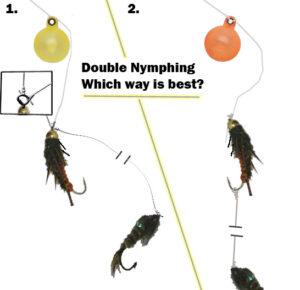
Don’t forget, the fish have not taken the day off from eating, there is something you can present to them that they will eat. So now is the
time to bring out the big guns. Grab a strike indicator and tie on as many nymphs as legally allowed in your area. This might sound a little crazy, but all you need to do at this point is to isolate one fly that one fish will eat. It might be that crazy little red flashy fly that you have always assumed was worthless. Tie it on and try! Use the multiple nymph rig technique and lambaste that hole! Keep trying different nymphs until you catch a fish.
#4: Finally, I Have Managed To Land a Trout on Some Whacked out Nymph!
(If not, skip to #5)
If yes, read on:
OK, so you now have a real live trout in your presence, what are you going to do now to make this trout help you catch more? Pump it Baby! You have probably seen the trout stomach pumps before right? They are similar to small turkey basters and will allow you to gently extract the contents of the trout’s stomach to identify what exactly they have been feeding on. They are totally harmless to the fish (other than taking their hard days feeding effort away). Once you isolate a specimen from the trout, you will hopefully have a similar fly in one of your boxes to replicate it. If these fly fishing tips haven’t worked yet, you still have a chance to hook fish. Keep reading..
#5: I Cannot Catch Any Trout, Not Even After Pounding My Best Spots With Every Nymph I Own.
Fear not, our trout fishing tips are not yet exhausted. How is the water color? Is it stained and high after a huge rain or spring runoff? This is a common situation in some areas and there are fly patterns that will work here. High water will erode banks and heavy rain will get the worms and night crawlers moving. No, I am not going to tell you to dig up some worms (even though that would probably work). Use the San Juan Worm! You should have some of these already in red and pink, if not you need to go hit the vice and tie some up. They make for a great last resort fly and have saved the day for me many occasions. These can become a number one fly for high/dirty water conditions.
#6: UHHG, I Can’t Even Catch Fish On a San Juan Worm.. Now What?
Streamers! These are known for working splendidly in high and dirty water. In this case ,usually black is a good choice, but you should try several until you have exhausted every possibility. If the fish are not eating large streamers, you should also try some very small versions as well. Usually I will start big and heavy and work my way down to smaller flies. If you find a streamer that the fish are showing some interest in (such as flashing them or following without hitting) that is a good sign that you are on the right track. If they are flashing and following, you should stick with the same color configuration but downsize. Often times a smaller size will be just what it takes to convince sluggish trout to commit to eating.
#7: Try Multiple Species:
Brown trout will generally hold in different areas than rainbows and cutthroat trout. I have noticed on certain days that rainbows will be eating like crazy, but the brown trout won’t eat a thing. The same can be said for brook trout and every other trout species. If you decide to target specific species, you might have a better shot at turning your tough day fishing into a success.
If you find that rainbow trout will eat, but the browns won’t, this should be your game plan (if it applies to your situation). This is a general scenario. Trout will sometimes hold in different water types, depending on what is available in your body of water.
- Target only likely areas for rainbow trout: This will usually include fast water around large boulders.
- There are certain colors of nymphs that I have found to be particularly attractive to rainbows, such as pink and red. You can use these flies in areas that you know hold rainbow trout to increase catch rates.
Modify the above scenario to target known holding areas for the species you decide to give your attention. If only one species of trout is feeding regularly on a certain day, you can save a lot of time by only going after said species.
In Conclusion – How to Fly Fish for Trout
This is a culmination of my 30 years spent fly fishing for trout. I offer some of my best trout fishing tips above. If this information does not help you to catch more fish, I am not sure I can help you. There are some days where the trout really aren’t feeding very much and you just cannot do anything about it. By employing these tips throughout the years, I cannot think of a time where I was skunked in the last 15 years, however it is possible that I just blocked the memory of those fish free days.
Check back here again, because I will be adding more information frequently. All of this info took me 30 years of fly fishing to acquire, so I hope it will help you on your way to finding out how to fly fish for trout better than ever.

